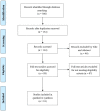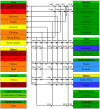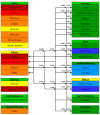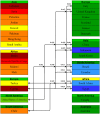Global COVID-19 Vaccine Acceptance: A Systematic Review of Associated Social and Behavioral Factors
- PMID: 35062771
- PMCID: PMC8779795
- DOI: 10.3390/vaccines10010110
Global COVID-19 Vaccine Acceptance: A Systematic Review of Associated Social and Behavioral Factors
Abstract
COVID-19 vaccines have met varying levels of acceptance and hesitancy in different parts of the world, which has implications for eliminating the COVID-19 pandemic. The aim of this systematic review is to examine how and why the rates of COVID-19 vaccine acceptance and hesitancy differ across countries and continents. PubMed, Web of Science, IEEE Xplore and Science Direct were searched between 1 January 2020 and 31 July 2021 using keywords such as "COVID-19 vaccine acceptance". 81 peer-reviewed publications were found to be eligible for review. The analysis shows that there are global variations in vaccine acceptance among different populations. The vaccine-acceptance rates were the highest amongst adults in Ecuador (97%), Malaysia (94.3%) and Indonesia (93.3%) and the lowest amongst adults in Lebanon (21.0%). The general healthcare workers (HCWs) in China (86.20%) and nurses in Italy (91.50%) had the highest acceptance rates, whereas HCWs in the Democratic Republic of Congo had the lowest acceptance (27.70%). A nonparametric one-way ANOVA showed that the differences in vaccine-acceptance rates were statistically significant (H (49) = 75.302, p = 0.009*) between the analyzed countries. However, the reasons behind vaccine hesitancy and acceptance were similar across the board. Low vaccine acceptance was associated with low levels of education and awareness, and inefficient government efforts and initiatives. Furthermore, poor influenza-vaccination history, as well as conspiracy theories relating to infertility and misinformation about the COVID-19 vaccine on social media also resulted in vaccine hesitancy. Strategies to address these concerns may increase global COVID-19 vaccine acceptance and accelerate our efforts to eliminate this pandemic.
Keywords: COVID-19; associated factors; global variations; systematic review; vaccine acceptance; vaccine hesitancy.
Conflict of interest statement
The authors declare no conflict of interest.
Figures







References
-
- Pišot S., Milovanović I., Šimunič B., Gentile A., Bosnar K., Prot F., Bianco A., Lo Coco G., Bartoluci S., Katović D., et al. Maintaining everyday life praxis in the time of COVID-19 pandemic measures (ELP-COVID-19 survey) Eur. J. Public Health. 2020;30:1181–1186. doi: 10.1093/eurpub/ckaa157. - DOI - PMC - PubMed
-
- Aslam F., Awan T.M., Syed J.H., Kashif A., Parveen M. Sentiments and emotions evoked by news headlines of coronavirus disease (COVID-19) outbreak. Hum. Soc. Sci. Commun. 2020;7:1–9. doi: 10.1057/s41599-020-0523-3. - DOI
Publication types
LinkOut - more resources
Full Text Sources
Miscellaneous

